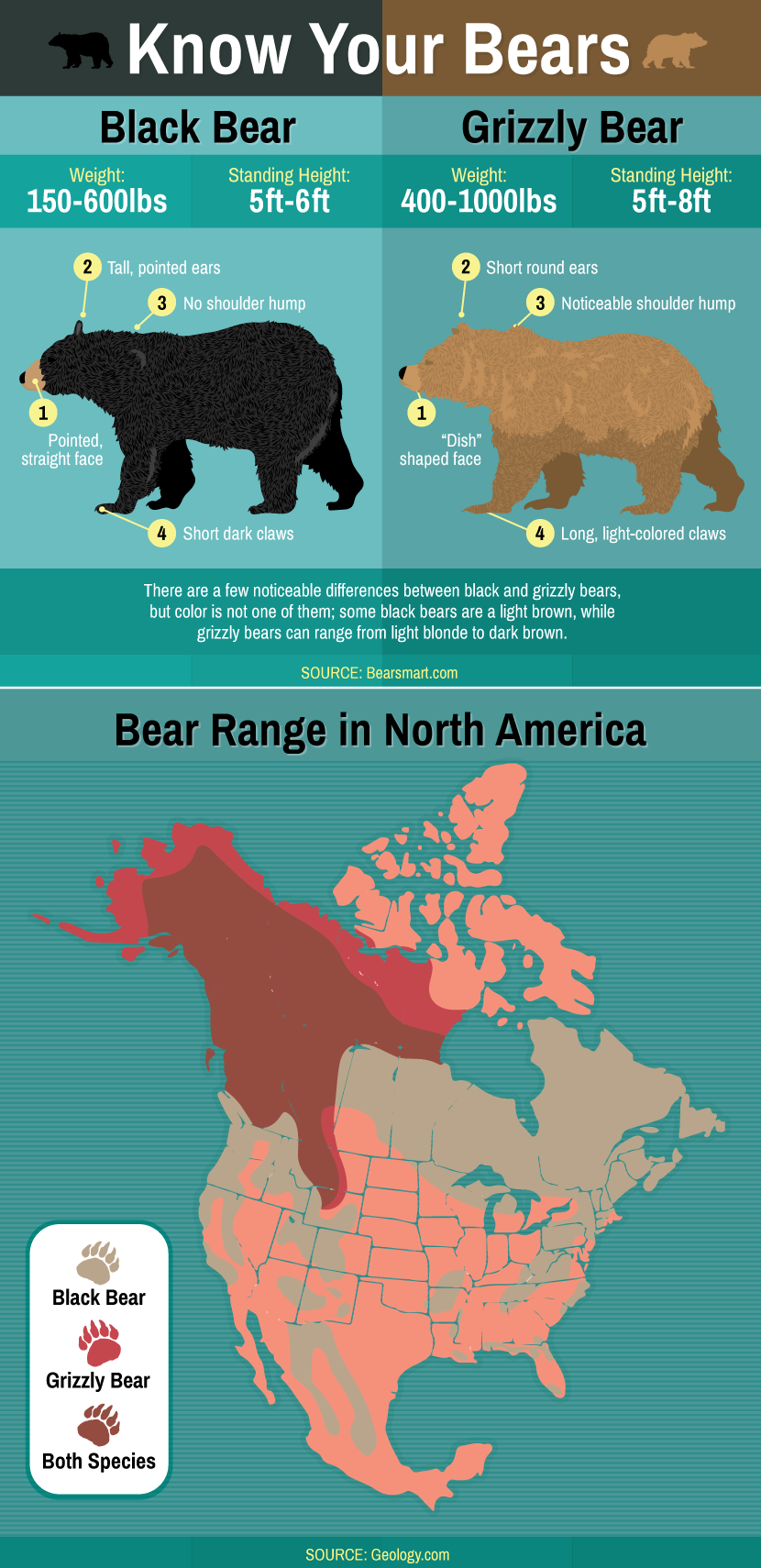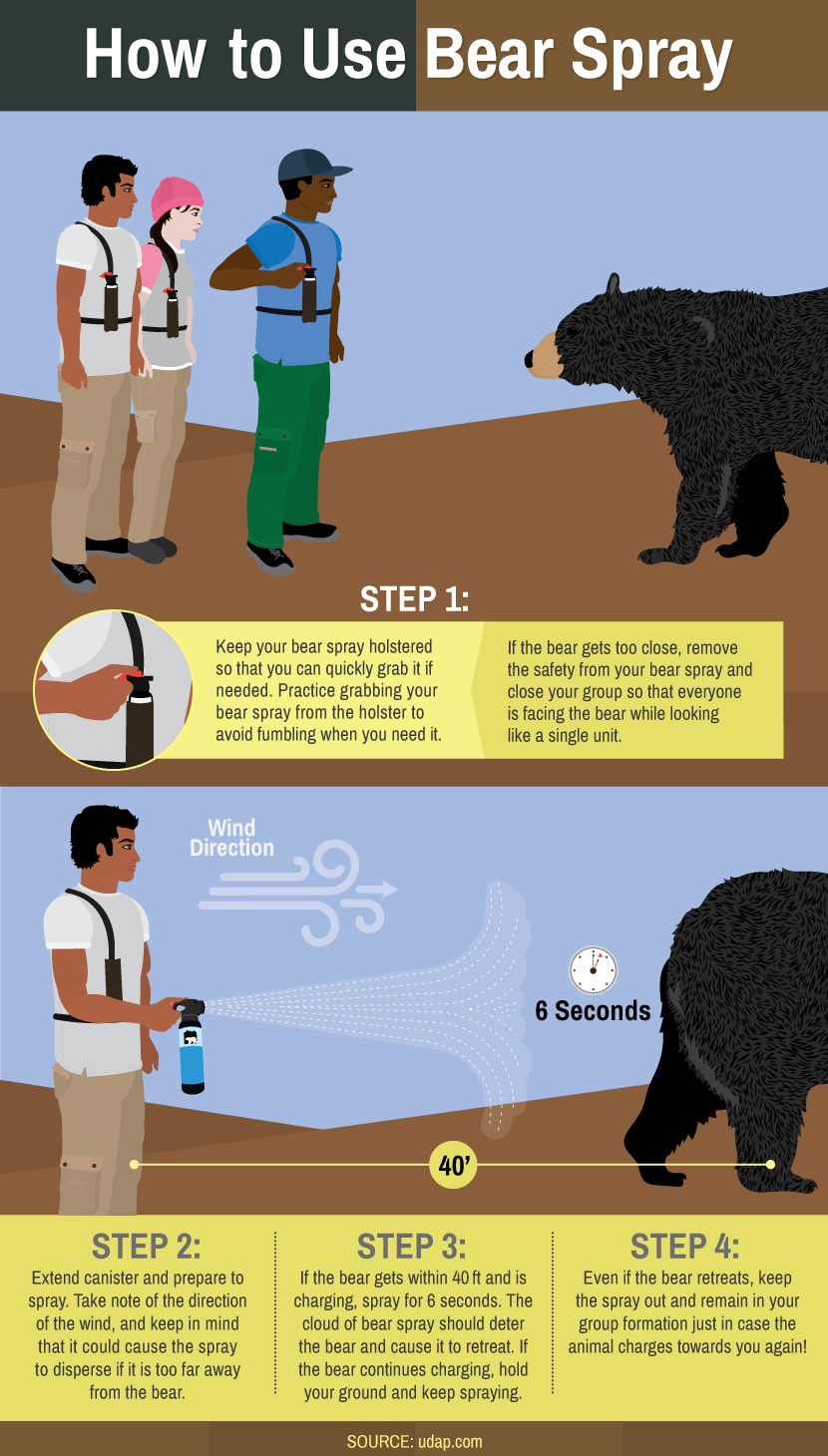Getting to Know Bears
Be Bear Aware
In most of America, hiking in the backcountry means hiking in bear country. Because of their size and strength, bears have a negative reputation, but bear attacks are relatively rare. To further decrease your chance of having an encounter with a bear,
there are a few simple steps to follow, including gaining an understanding of how bears evolved and how they act.
Bear Species
There are three prominent bear species in North America: black, grizzly, and polar. Hiking in polar bear country is a unique endeavor that requires a specialized approach because they are the only species known to hunt humans as a food source.
This article will focus on grizzlies and black bears, which are more common and easier to defend against.

Neither black bears nor grizzly bears are known for hunting humans; most attacks are the result of a startled bear, a sow defending her cubs, or a bear that has been fed by humans searching for more food.
Black bears evolved in forested regions where retreating could mean hiding. For this reason, black bears are less likely to defend their cubs by attacking.
Grizzlies, on the other hand, evolved in open spaces, such as the tundra and grassy alpine regions, which affected their flight-or-fight response.
Grizzly bears are more likely to defend their young by fighting than they are to flee. For this reason, it’s more important to be “bear aware” when traveling in grizzly country.
Both species are capable runners; black bears can average 25–30 mph, while grizzly bears can sprint at 35 mph and have been estimated to reach top speeds of 41 mph.
To give a rough comparison, 30 mph is equal to 44 feet per second – an unattainable feat for humans.
The most important step toward preventing a bear attack is to never feed a bear. A common saying is “a fed bear is a dead bear.” Bears that have learned to equate humans with food become more aggressive and less afraid.
Be sure to keep your food in a safe and secure location when traveling in bear country.

While hiking, make sure any bears know you are present before you are seen. A startled grizzly is more prone to charge if it is surprised by your presence.
When done correctly, bear calls are an effective technique. It doesn’t really matter what you say for your bear call, but most people find that “Hey, Bear” works well because it’s easy to remember and it’s different from normal conversation.
Volume is important. Being loud isn’t very comfortable, and the silence of the wilderness is one of its strongest draws, but quiet bear calls are useless.
Be assertive – the goal is for nearby bears to realize that a large animal is nearby.
When possible, hike in a group. A group of three or more has a larger presence, which will lessen your chances of a negative bear encounter because that number is a lot for a single animal to defend against.
While traveling in open areas where it’s more likely that a bear will see you coming (or that you will see the bear), it’s less important to make bear calls.
Be aware of terrain traps, areas in which a bear might be more surprised because its vision or hearing is compromised. Some common examples are dense shrubs and running water.
It’s also important to consider your own condition: are you tired and therefore less aware of your surroundings, or did you just come across fresh bear scat and bears are fresh on your mind?
These differences affect how often you should make bear calls.
Bear Spray
If you’re hiking and camping in grizzly country, invest in a can of bear spray. Modeled after the little canisters that you can carry to deter human or dog attacks, bear spray is a much more powerful concentration of capsaicin that shoots out at a higher speed (~60 mph).
Canisters usually cost around $50, and they cannot be carried on airplanes; however, in some parks, such as Yellowstone, you can rent bear spray by the day. Owning bear spray is only half the battle; it's important to keep it handy while hiking.
Do not pack your bear spray in your backpack. Attach the holster to your backpack so the can is accessible.
When hiking in areas with a dense grizzly population, consider buying a chest harness for your bear spray and wear it at all times. There’s no need to sleep with the bear spray on, but keep it within reach of your tent entrance.

What to Do if You See a Bear
If the bear is far away and doesn't seem to have noticed you, remain quiet and slowly back away. Keep the bear spray handy in case the bear suddenly notices your presence.
If the bear has noticed you, start talking to it and get big. For groups, this means standing shoulder to shoulder, which gives the appearance that you are one large animal rather than a few small humans. Remain calm and stay in one place.
If the bear charges, hold the spray in front of you and remove the safety. Wind direction and rain will affect the spray’s effectiveness. If you shoot upwind, you will get the spray in your face.
If possible, shoot downwind to avoid being temporarily blinded by the spray. Don’t use every can in the group because you won’t have anything left if the bear charges again or if you have another bear encounter later in your trip.
It often surprises people that bears are attracted to the smell of bear spray, but it’s true. This doesn't mean it’s ineffective; the speed at which it is expelled makes it a great deterrent.
However, any clothes that have spent bear spray on them should be kept with other smellable items, such as kitchen supplies.

Fear of bears shouldn’t keep you from hiking and camping. It’s more common to see the retreating form of a bear than to have a face-to-face encounter.
Sharing wild spaces with these animals is one of the perks of backcountry travel, and knowing how to do so safely will give you confidence on your next trip.
If you’re lucky, you’ll have the opportunity to admire a bear from a safe distance.
Embed the article on your site

